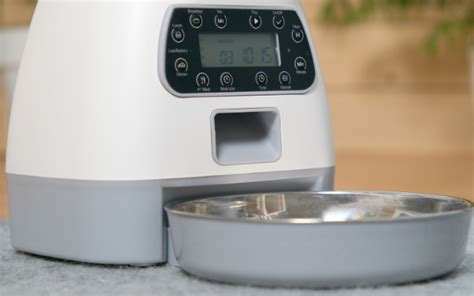Introduction
Caring for pets is a time-consuming task that often requires busy owners to sacrifice their own schedules to ensure their furry friends are fed on time. Fortunately, advances in technology have introduced smart feeding technology that promises to revolutionize the way we feed our pets, offering convenience, precision, and peace of mind. This article explores the latest trends and innovations in smart feeding technology, comparing its benefits and drawbacks with traditional feeding methods.

Smart Feeding Technology: Benefits and Features
Smart feeders are automated devices that connect to the internet, allowing pet owners to remotely schedule and dispense food portions. They typically include:
- Wi-Fi connectivity: Allows owners to control the feeder from anywhere with an internet connection.
- Scheduled feedings: Programmable timers ensure pets are fed at specific intervals, eliminating the need for manual feeding.
- Portion control: Precisely dispenses food portions, preventing overfeeding and promoting healthy weight management.
- Monitoring: Some feeders monitor pet eating habits, providing insights into their health and well-being.
Traditional Feeding VS Smart Feeding: A Comparison
| Feature | Traditional Feeding | Smart Feeding |
|---|---|---|
| Convenience | Requires manual feeding at specific times | Automated feeding, remote control |
| Precision | Inconsistent portions, potential for overfeeding | Precise portion control, prevents overfeeding |
| Monitoring | Limited observation of eating habits | Track feeding patterns, detect changes in appetite |
| Cost | Typically less expensive | Higher upfront cost, but potential long-term savings |
| Reliability | Prone to human error | Automated system reduces risk of missed feedings |
Wants and Needs of Busy Pet Owners
- Convenience: Busy owners prioritize automated feeding systems that eliminate manual feeding and allow for remote control.
- Peace of mind: Smart feeders provide assurance that pets are fed on time, even when owners are away or unable to attend to them.
- Health monitoring: Owners seek devices that monitor pet eating habits, helping them identify potential health issues early on.
- Cost-effectiveness: While smart feeders may have a higher upfront cost, their long-term savings through portion control and reduced vet bills can outweigh the initial investment.
Strategies for Implementing Smart Feeding Technology
Owners considering smart feeding technology should:
- Research different feeders: Compare features, reviews, and price points of various models to find the best fit.
- Consider pet size and dietary needs: Ensure the feeder can accommodate the pet’s food requirements and portion size.
- Establish a feeding schedule: Program the feeder with optimal feeding times and amounts, based on the pet’s age, activity level, and health conditions.
- Monitor pet eating habits: Use the feeder’s monitoring features to track the pet’s food intake and identify any changes that may indicate illness or stress.
- Clean and maintain the feeder: Regular cleaning prevents food spoilage and ensures the feeder operates optimally.
Common Mistakes to Avoid
- Overreliance on technology: Smart feeders should complement responsible pet ownership, not replace human interaction and attention.
- Ignoring portion control: While smart feeders automate feeding, owners must still set appropriate portion sizes to prevent obesity.
- Neglecting pet health monitoring: Reliance on smart feeders should not deter owners from observing pet eating habits and seeking veterinary care when necessary.
- Poor feeder placement: Place the feeder in a quiet, easily accessible location to minimize stress for the pet.
- Unreliable Wi-Fi: Ensure a stable Wi-Fi connection to avoid disruptions in scheduled feedings.
Innovations and Future Outlook
Smart feeding technology continues to evolve, with innovations such as:
- Artificial intelligence (AI): AI-powered feeders can adjust feeding schedules based on the pet’s activity levels and environmental factors.
- Camera integration: Feeders with built-in cameras allow owners to interact with their pets remotely, providing additional peace of mind.
- Biometric identification: Feeders that use facial or voice recognition can identify specific pets and dispense food accordingly.
- Pet-proof designs: Advanced feeders incorporate pet-proof mechanisms to prevent accidental activations or unauthorized access to food.
Conclusion
Smart feeding technology offers busy pet owners a convenient and effective solution to ensure their furry companions are well-fed, even when time is scarce. By considering their pet’s needs, researching and implementing smart feeding technology effectively, owners can enjoy the peace of mind that comes with knowing their pet’s nutritional well-being is being taken care of. As technology continues to innovate, smart feeding systems are poised to become an indispensable tool for responsible pet owners in the coming years.
Additional Information
- By 2025, the global smart pet feeding market is projected to reach $1.5 billion, driven by rising pet ownership and the growing adoption of technology in pet care.
- Studies have shown that smart feeders can improve pet eating habits, reduce the risk of obesity, and enhance overall pet health and well-being.
- Pet owners can “hack” smart feeding technology to create custom applications, such as voice-activated feeding, treat dispensers, or even interactive games with their pets.





















